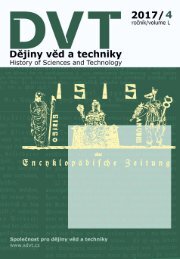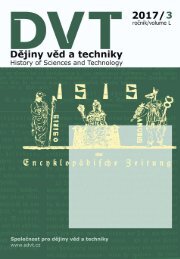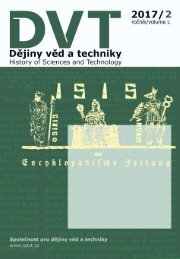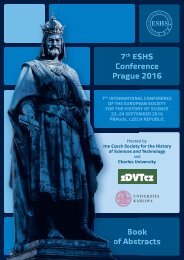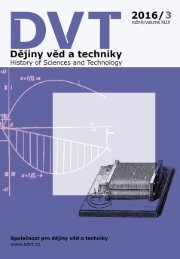Dějiny věd a techniky 2015, 4
Číslo je věnováno 7. mezinárodní konferenci Evropské společnosti pro dějiny vědy, která se konala 22.–24. září 2016 v Praze.
Číslo je věnováno 7. mezinárodní konferenci Evropské společnosti pro dějiny vědy, která se konala 22.–24. září 2016 v Praze.
You also want an ePaper? Increase the reach of your titles
YUMPU automatically turns print PDFs into web optimized ePapers that Google loves.
ČLÁNKY / papers<br />
the “pre-March” period, the more fiercely physicians engaged in campaigns for<br />
reforms in medicine. Seebacher claims that the Revolution of 1848 in Vienna<br />
was prepared in the dissecting rooms of the Medical Faculty, where political<br />
discussions could take place without state control. Rokitansky and Skoda, who<br />
in the meantime had become professors in Vienna, showed their support for<br />
the Revolution and their own egalitarian politics by enlisting in the “Academic<br />
Legion” as common soldiers, rather than accepting officers’ commissions.<br />
As Seebacher also writes, after the Revolution’s defeat Škoda, Rokitansky<br />
and others continued their efforts to establish science-based medical curricula<br />
within the context of reformed university structures. Vienna thus took full<br />
advantage of the intellectual capital from Prague. However, the durability of<br />
this Prague-Vienna linkage came into question in the 1870s, as newly appointed<br />
German professors introduced “German” models of research and training.<br />
In his paper, Attila Szilárd Tar presents a brief overview of study-tours by<br />
students and teachers from the Technical University of Budapest in Europe from<br />
1899 to 1914. The Technical University of Budapest was a young institution at<br />
the end of the 19 th century, having been founded in 1871, though it had some<br />
forerunners from the 1840s. As Tar suggests, Hungarian technical schools tried<br />
to copy the German model, but to do this they needed information about this<br />
type of higher education. He outlines several modes of information-collection<br />
and academic exchange: inquiries to German technical colleges and universities<br />
in letters; arranging excursions to partner institutions; and honorary doctoral<br />
degree awards, as well as memberships granted to Hungarian professors in German<br />
scientific academies or societies.<br />
Focusing mainly on study tours of students and teachers to German institutions<br />
in order to gain knowledge and practical experience, Tar shows that the Hungarian<br />
Ministry for Education and Religion granted stipends to support these tours, but<br />
insisted on a detailed, formalized procedure for applying for these stipends,<br />
required interim and final reports of the results, and also expected that participants<br />
would return and put their new knowledge to use in Hungary. In addition to<br />
education institutions, students and younger faculty members also visited factories,<br />
public institutions and non-university research institutes. The documents in the<br />
archives list 17 people who were sent abroad from the Technical University of<br />
Budapest during this period; in addition one teacher was sent three times within<br />
15 years. The main destination of these tours was Germany, but sometimes<br />
German locations were included as part of a wider Central-European journey.<br />
Further research is needed to determine exactly what technical or scientific<br />
knowledge these Hungarians brought back with them, and how this knowledge<br />
may have been transformed in new contexts.<br />
”Provincial“ Universities and Scientific Networks in the Habsburg Monarchy.<br />
201




